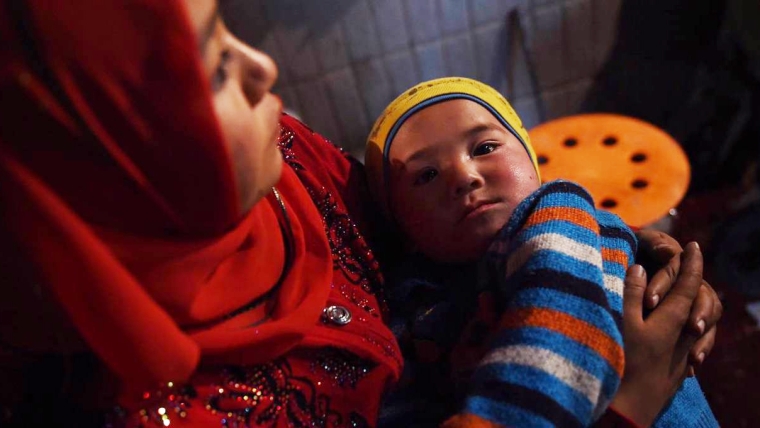
After becoming the Communist Party of China’s chief of Xinjiang Province in 2016, Chen Quanguo oversaw a security crackdown that led to a drop in births so sharp that it shocked the world. Some observers accused China’s leadership of committing genocide against the province’s mostly Muslim Uyghur population through forced sterilisation and abortion. Chinese Foreign Minister Wang Yi dismissed the allegations as “fake news,” arguing that Xinjiang’s Uyghur population had grown steadily to 12.7 million in 2018, an increase of 25% from 2010 – and higher than the 14% increase in the province’s total population.
But recently released 2020 census figures have delivered what amounts to a slap in the foreign ministry’s face. The data show that in 2020, Xinjiang’s Uyghur population had grown by only 16% since 2010, to 11.6 million, compared to a 19% increase in Xinjiang’s total population. Even more shocking, the Uyghur population aged 0-4 was only 36% the size of that aged 5-9.
The only comparable antecedent to this plunge in births was in Shandong Province in the early 1990s, where some Party officials tried to launch a campaign to go “newborn-free in 100 days.” By 2000, the population of 5-9 year olds in Tai’an, a city in Shandong, was only 28% the size of the cohort aged 10-14. Back in 1980, when Chinese authorities were discussing the one-child policy, there was even a creepy proposal to have a “newborn-free year” every few years.
To understand why Xinjiang’s births have plummeted, it helps to review the history of population control in the province. China implemented family planning nationwide in 1973 and imposed the one-child policy in 1980. But for ethnic minorities in Xinjiang, family planning came later. Starting in 1989, minority urban couples in Xinjiang were allowed two children. Rural couples were allowed two as well, and were less likely to be forced to have abortions and sterilisations. Those “lenient” policies, combined with lagging education, led to higher fertility rates among Uyghurs. For example, the national fertility rates in 1989, 2000, and 2010 were 2.3, 1.22, and 1.18 children per woman, respectively, and 4.31, 2.0, and 1.84 for Uyghur women.
Chen’s predecessor, Zhang Chunxian, was keen on population control when he was CPC secretary of Hunan Province from 2005 to 2010. Arguing that “to grasp family planning is to grasp productivity,” he launched a campaign to strengthen family planning in Hunan in 2006. The campaign swept up my cousin-in-law, who was forced to abort her first child a few days before her due date because she had not applied for a birth permit in time.
In 2010, Zhang was reassigned to Xinjiang, and Hunan’s new governor, Xu Shousheng, arrived with plans to launch another campaign to strengthen population control in the province. In January 2011, I posted an “Open Letter to the Secretary and Governor of Hunan on Family Planning” online, euphemistically criticising Zhang and Xu. In response, the Hunan authorities invited me to lecture on the topic in Hunan, and Ilham Tohti, a Uyghur economist and award-winning human-rights defender, joined me in calling for an end to family planning for the Uyghurs.
Then, on July 31, 2014, Zhang published an essay in the CPC journal Seeking Truth, arguing that Xinjiang must “implement a family-planning policy that is equal for all ethnic groups” and must “lower and stabilise fertility at a moderate level.” I was so concerned that in March 2015, I published a peer-reviewed response in the journal Population and Society, entitled “The urgency of stopping population control in view of the low fertility rates of ethnic minorities.”
In the event, Zhang did not strengthen family planning in Xinjiang. Births in the province remained stable during his tenure. But we now know that, under Chen’s rule, births plummeted from 389,695 in 2017 to 267,250 in 2018, and to 159,528 in 2021, implying three-quarters of a million fewer births in 2018-21.
Since Chinese authorities have long been notorious for mandating abortion, sterilisation, and intrauterine devices, it is natural to assume that the dramatic decline in births in Xinjiang reflects such measures. But matters are not so simple, because there were slightly fewer abortions and IUDs in Xinjiang in 2017-20 than in 2013-16; and though there were 70,000 more sterilisations, that figure is still an order of magnitude smaller than the drop in births.
Given that couples in Xinjiang can legally have two or three children, it is unlikely that the authorities systematically forced abortions, ligations, and IUDs on women who had only one or two children. Why, then, was the Uyghur fertility rate in 2020 only one child per woman? Most likely, it is because Chen’s brutal crackdown both undermined Uyghur fertility habits (under the pretext of fighting Islamic extremism) and reduced the resources for parenting, through economic recession and rising unemployment. As rural Xinjiang suffered severe cultural repression and economic deprivation, the fertility rate in 2020 fell to an unusually low level compared to the province’s urban areas.
Moreover, improved education has also contributed partly to the decline in births, by leading more women to delay marriage and childbearing. Chinese authorities have invested heavily to provide 15 years of free compulsory education in Xinjiang, compared with nine years nationwide. As a result, Xinjiang’s high-school gross enrollment rate increased from 69% in 2010 to 99% in 2020, while the nationwide rate rose from 83% to just 91%. Uyghurs have suffered from forced sterilisation, of course. But it is this forced cultural shift that appears to have had more serious consequences for the birth rate.
While the Chinese authorities have been very effective at lowering fertility rates, they have proved to be far less competent at boosting them. The recent “two-child” and “three-child” policies have both been abject failures. Looking ahead, every effort to encourage procreation in Xinjiang will fail if the region’s socioeconomic vitality continues to decline.
This failure will cause China to lose its geopolitical advantage in Central Asia, where it is in a struggle for influence with Russia. China’s rulers have heaped praise on Chen, but they have yet to recognise that his security crackdown in Xinjiang sowed the seeds of severe long-term problems.
Yi Fuxian, a senior scientist in obstetrics and gynecology at the University of Wisconsin-Madison, is the author of Big Country with an Empty Nest. Copyright 2022 Project Syndicate, here with permission.
11 Comments
To conclude this article, the genocide in Xin Jiang is indeed a dirty smear campaign by the US. Xin Jiang population grew by 16% from the past decade.
the US calls a 16 per cent population growth a genocide. that is beyond joke.
Uyghurs have suffered from forced sterilisation, of course.
Did you and I read the same article? The article I read seems to conclude the genocide is real, not a smear campaign.
Recently released 2020 census figures have delivered what amounts to a slap in the foreign ministry’s face. The data show that in 2020, Xinjiang’s Uyghur population had grown by only 16% since 2010, to 11.6 million, compared to a 19% increase in Xinjiang’s total population. Even more shocking, the Uyghur population aged 0-4 was only 36% the size of that aged 5-9.
Did we read the same article?
The data show that in 2020, Xinjiang’s Uyghur population had grown by only 16% since 2010
I think the overall population growth of China is far below 16%. The 19% increase in Xinjiang’s population was because of migration as the area is under repaid development.
So data is data, just how you want to present them.....
xing,
But recently released 2020 census figures have delivered what amounts to a slap in the foreign ministry’s face. The data show that in 2020, Xinjiang’s Uyghur population had grown by only 16% since 2010, to 11.6 million, compared to a 19% increase in Xinjiang’s total population. Even more shocking, the Uyghur population aged 0-4 was only 36% the size of that aged 5-9.
I don't know if what is being done to the Uyghur population qualifies as genocide, possibly not, but certainly as ethnic cleansing.
.
the one child policy had never extended to the minority groups in China, they can have as many children as they want. and the fertility rate in China has steadily dropped to historical lows, not in just in Xinjiang region. Uygurs are not the only minorities in Xinjiang, nor the only Muslims in Xinjiang, but they are the only group that connected to the Taliban.
It puts China in a difficult position. The US has a long history of funding, arming and training Islamic insurgents to fight communists and undermine competitors. I mean, that's such an obvious fact. Absolutely the US's modus operandi.
What’s been happening in that region is a disgrace. Despicable.
Surely the fact that half the Uyghurs are locked up in 're-education' camps has something to do with the lowering of the birth rate? I can't imagine one would be feeling very amorous after a day of re-education. I doubt couples even get to co-habit, given lots of the women left behind are forced to take a Han chinese model citizen into their bed.
China is reportedly sending men to sleep in the same beds as Uighur Muslim women while their husbands are in prison camps
https://www.businessinsider.com/china-uighur-monitor-home-shared-bed-re…
There is nothing good about communist leadership. Nothing.

We welcome your comments below. If you are not already registered, please register to comment
Remember we welcome robust, respectful and insightful debate. We don't welcome abusive or defamatory comments and will de-register those repeatedly making such comments. Our current comment policy is here.